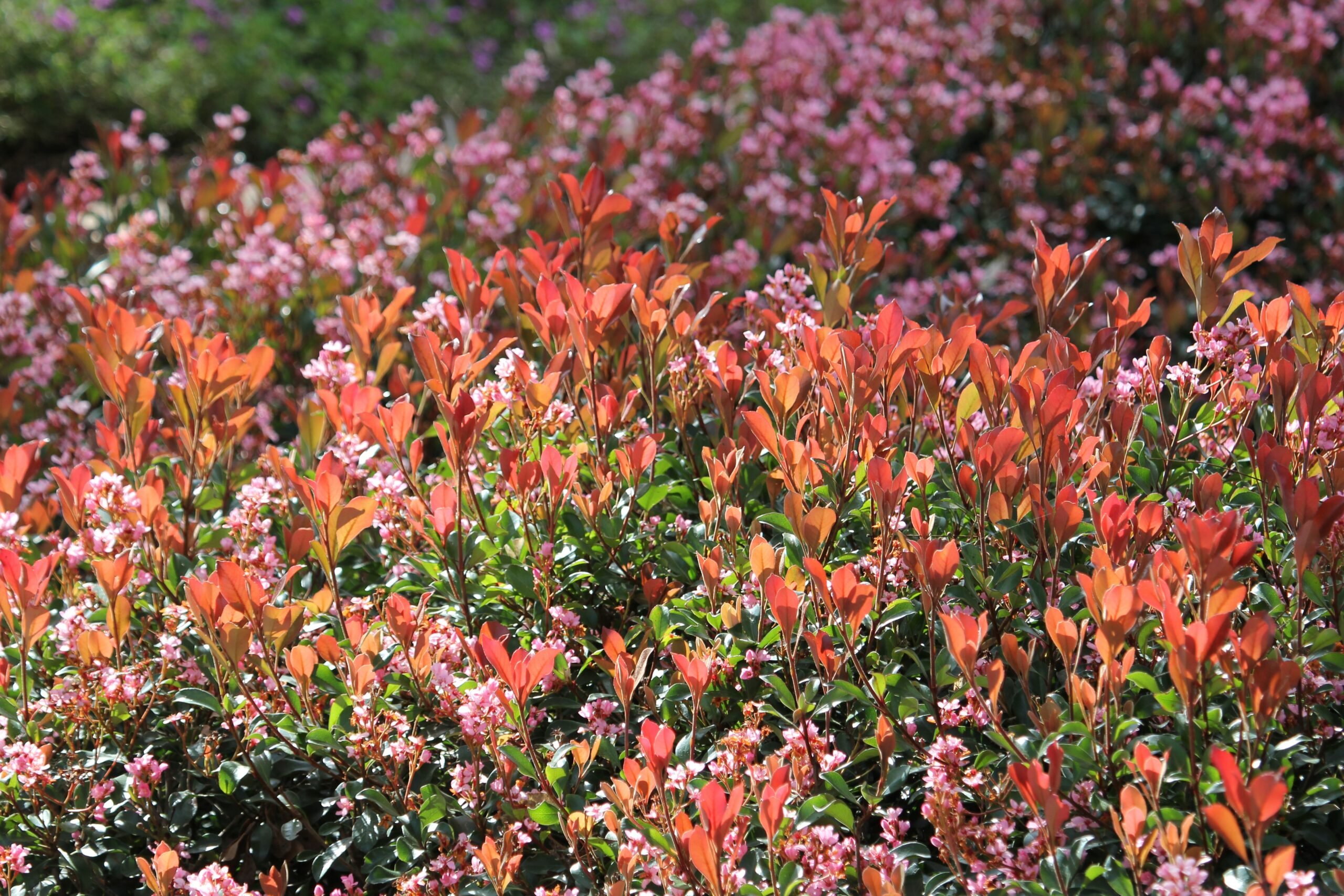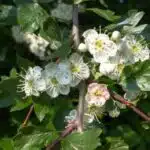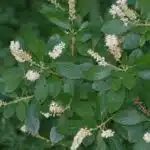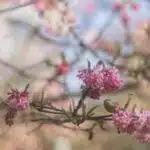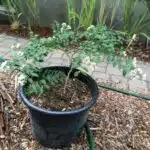Have you ever wondered why Indian Hawthorn is such a popular choice for landscaping? The answer lies in its hardiness, easy maintenance, and attractive foliage. This article will explain exactly how to grow and care for this versatile shrub. Read on to learn more about the basics of Indian Hawthorn and how to keep it looking its best!
As any botany or gardening specialist knows, Indian Hawthorn (Rhaphiolepis indica) is an evergreen shrub that grows throughout much of the southeastern United States. It has white or pink flowers in early spring and shiny black fruits. This plant can reach up to 8 feet tall and wide when grown in full sun, though it can also be trained as a low hedge around 3–4 feet tall. Indian Hawthorn is adaptable to most soils with good drainage and does not require much pruning or fertilizing for healthy growth.
This article will give readers all the information they need to successfully grow and care for Indian Hawthorn in their own yard or garden. Tips on choosing a planting location, preparing soil, watering schedules, pruning instructions, and even pest control will be discussed in detail so that anyone can become a successful gardener of this beautiful shrub!
Overview Of Indian Hawthorn
The Indian Hawthorn is a beautiful and useful shrub, offering an abundance of delicate white blooms in the spring and vivid foliage in the summer. A true gem for any garden, it’s easy to see why this plant is so popular with gardeners. With a few simple tips and tricks, you can have your own thriving Indian Hawthorn in no time.
When it comes to caring for your Indian Hawthorn, there are certain key points you should consider. First and foremost, you’ll want to make sure that you provide ideal growing conditions. This means making sure that it has plenty of water during dry spells, as well as enough light but not too much direct sunlight which could burn the leaves or cause wilting. You’ll also need to ensure that your soil is well-draining and free of weeds, which can compete with the plant for nutrients and moisture.
Finally, it’s important to fertilize your Indian Hawthorn regularly throughout the growing season with a balanced fertilizer. You can also add some organic matter such as compost or manure to give an extra boost of nutrients. Pruning should be done very carefully and sparingly; only remove dead or damaged branches or stems to help maintain shape and encourage healthy new growth. With these simple steps in mind, you’ll be able to enjoy a flourishing Indian Hawthorn for years to come!
Ideal Growing Conditions For Indian Hawthorn
Indian hawthorn is an attractive flowering shrub that provides year-round interest in many gardens. Its ideal growing conditions make it a popular choice for gardeners looking to add some color to their landscape.
When considering ideal growing conditions for Indian hawthorn, climate is the most important factor. This variety thrives in temperate climates, with winters that are mild and not too cold. It prefers full sun but can tolerate light shade, although it will flower less profusely if shaded. Indian hawthorn does best in well-draining soil with a pH of 6.0 to 6.5; it will suffer from root rot in soils with higher pH levels. Watering should be done deeply and regularly during dry spells; however, this shrub does not tolerate standing water so care should be taken not to overwater.
Fertilizer should be applied lightly each spring to encourage both blooming and foliage growth; fertilizers specifically formulated for acid-loving plants are preferred, as Indian hawthorn requires an acidic soil environment to thrive. Pruning is optional — only remove dead or diseased branches — as this shrub tends to grow naturally into an attractive shape without much intervention from gardeners. With the right conditions and minimal care, Indian hawthorn can provide years of enjoyment with its colorful blooms and glossy green leaves.
Planting Indian Hawthorn
With all the effort put in, you’d think planting Indian hawthorn would be a breeze. But alas, it’s not as simple as just digging a hole and throwing it in! Believe it or not, there’s an art to planting these gorgeous flowering shrubs. Here we’ll take a look at what it takes to get them planted right and thriving.
First off, let’s talk location. Indian hawthorn prefers full sun but they can tolerate some shade. Choose an area with well-draining soil that gets at least six hours of sunlight each day. It’s also important to keep in mind that the root system of Indian hawthorn is shallow so make sure to give them plenty of space for their roots to spread out without crowding any other plants or structures.
Now for the actual planting process. It’s best to plant your Indian hawthorn during cooler months when temperatures are lower and rainfall is more frequent – typically late fall or early spring are ideal times for planting. Make sure the soil is damp before planting and dig a hole that’s twice as wide and just as deep as the pot your plants come in. Place your Indian hawthorn in the hole and fill in with soil until even with the ground level then water thoroughly until you see moisture seeping from the bottom of the pot.
When done properly, planting Indian Hawthorn will ensure years of beauty and enjoyment! With correct conditions, these stunning shrubs can bring life into almost any landscape design – no matter how small or large your outdoor space may be.
Caring For Indian Hawthorn
Caring for Indian hawthorn is an art and a science. Like a master painter, one can bring out the full beauty of this evergreen shrub with careful attention to detail. To ensure your Indian Hawthorn is flourishing, follow these four steps like a scientist: pruning, fertilizing, pest management, and mulching.
Pruning is essential to help keep the plant healthy and shapely. Prune lightly in July after flowering to remove any dead or damaged branches. Also prune back any branches that are growing too long for their desired size. Doing this regularly will encourage thick growth, as well as blooms from new shoots in later seasons.
Fertilizing is important for ensuring good blooms and foliage growth. Use an all-purpose fertilizer during the spring before new growth appears so that the roots can take up the nutrients and use them for flowering later on. Make sure not to over-fertilize as it can cause excessive leaching of nitrogen into the soil which may lead to poor plant health or even death.
Pest management is also important when caring for Indian Hawthorn shrubs. Check your plants regularly for signs of pests such as aphids, mites, and scale insects that may be damaging foliage or robbing it of its vital nutrients. If you do find any pests present then use an appropriate insecticide as soon as possible to get rid of them quickly before they cause serious damage. Additionally, mulching around the base of these plants can help prevent root rot by keeping moisture levels consistent throughout the soil while also providing extra nutrients to boost overall plant health.
With these four simple steps – pruning, fertilizing, pest management and mulching – you can make sure your Indian Hawthorn shrub stays healthy and vibrant throughout each season!
Watering Indian Hawthorn
Watering Indian Hawthorn is a delicate balance between providing enough moisture to keep the plant healthy and not drowning it in too much water. It’s like carefully walking a tightrope; one misstep can cause the whole thing to come crashing down. To ensure successful growth of your Indian Hawthorn, here are some do’s and don’ts for watering it:
Do: • Water your Indian hawthorn deeply and infrequently. • Check its soil moisture levels often for signs of dryness. • Water thoroughly in times of prolonged dry spells.
Don’t: • Overwater your plant or allow it to stand in water-filled saucers or trays. • Allow the roots to be exposed to drying winds or direct sunlight as this could cause dehydration. • Let it go without water for long periods of time as this will stunt growth and leave it vulnerable to diseases.
When first planting, you should water well at least two times a week until the plant is established and growing vigorously. As the plant matures, you should reduce watering frequency but make sure that when you do water, you give your Indian Hawthorn deep irrigation so that all its root system gets moistened adequately. If you follow these guidelines, your Indian Hawthorn will thrive and be an attractive addition to your garden!
Fertilizing Indian Hawthorn
Indian Hawthorn is a popular shrub, with over one hundred different varieties. It is a favorite of many gardeners due to its low maintenance nature and beautiful evergreen foliage. To ensure your Indian Hawthorn thrives, it’s important to fertilize it regularly in addition to watering it. Here are some tips on how to do so.
When it comes to fertilizing, the key is timing. The best time for fertilizing Indian Hawthorn is in the springtime when new growth appears. A balanced fertilizer such as 10-10-10 or 8-8-8 should be applied at the base of the plant at a rate of 1 pound per 100 square feet of ground area. If you are using granular fertilizer, spread it evenly around the root zone and water thoroughly afterwards. For liquid fertilizer, apply it according to directions on the label.
You should avoid overfertilizing your Indian Hawthorn as this can lead to excessive growth and can reduce flowering and fruiting capabilities in some varieties. Instead, opt for light applications every two weeks during active growing months or use a slow release fertilizer once per season in early spring or late fall for long lasting results. If you have an established shrub that isn’t showing signs of nutrient deficiency, then you can skip fertilizing altogether.
Fertilizing your Indian Hawthorn correctly will help promote strong and healthy growth which will ensure your shrubs looks its best for years to come! Now let’s discuss pruning techniques for this versatile shrub…
Pruning Indian Hawthorn
Pruning Indian Hawthorn may seem daunting, but it can be an important step in keeping your shrubs healthy and beautiful. While some gardeners may think that pruning is unnecessary or even harmful to their plants, the truth is that proper pruning techniques can help promote growth and keep plants looking their best. As a specialist in botany and gardening, I am here to show you how to properly prune your Indian hawthorn for optimal health and beauty.
The first step when it comes to pruning Indian hawthorn is to understand the process of dormancy. During the late fall and winter months, most plants enter a period of dormancy where they are not actively growing or blooming. Before beginning any pruning work on Indian hawthorn, make sure it is fully dormant by waiting until late winter or early spring. This will ensure that no new growth is damaged during the pruning process.
Once your plant has fully entered its dormant period, you can begin lightly trimming away dead branches and stems as well as any crossing branches that could potentially cause damage or hinder future growth. Be sure not to over-prune as this can weaken the shrub’s overall structure and lead to an excess of new growth that may become unmanageable. Additionally, if desired you can lightly shape the shrub for aesthetic purposes without risking harm to the plant’s overall health.
By following these simple steps you should have no problem pruning your Indian hawthorn with confidence and success! With a little bit of patience and care, you should be able to maintain your shrub’s health while also achieving the look you desire. Now that we have discussed pruning techniques for Indian hawthorn let us move on to discussing common problems with these beautiful plants…
Common Problems With Indian Hawthorn
Believe it or not, common problems with Indian Hawthorn are actually quite rare. This is due to the hardy and resilient nature of these plants. In fact, many gardeners believe that Indian Hawthorn make the best choice for easy-care landscaping because of their ability to endure a variety of conditions. Here are some of the most common issues associated with this species:
• Pest infestation – scale insects, aphids, and other pests can cause damage to leaves and branches if left unchecked. • Disease – fungal diseases like Botrytis blight can affect both foliage and flowers if not treated quickly. • Overwatering – too much water can lead to root rot and other problems. • Insufficient sunlight – Indian Hawthorn needs a minimum of 6 hours of direct sunlight per day for optimal growth. • Poor soil drainage – if the soil does not drain well enough, the roots will be deprived of oxygen and eventually die off.
If you take proper care when planting your Indian Hawthorn, by providing it with adequate sunlight, nutrients, moisture and pruning when needed, you should have no major issues as far as pests or diseases go. A good compost mulch also helps keep weeds away while providing vital nutrition to the plant’s roots. With proper maintenance and protection from extreme weather conditions such as heat waves or cold snaps, your plant should remain healthy and vibrant for years! Now let’s look at how we can control pests and disease on Indian Hawthorn.
Controlling Pests And Disease On Indian Hawthorn
As the saying goes, “A healthy plant is a happy plant.” It’s important to take steps to keep Indian hawthorn plants healthy and pest-free. Controlling pests and disease on Indian hawthorn is an important part of proper care.
There are several insect pests that can damage Indian hawthorn plants, including aphids, mites, scale insects, thrips, and whiteflies. These pests feed on the leaves and stems of the plant, causing them to become distorted or discolored. To control these pests, use a horticultural oil spray or neem oil spray. If you have an infestation of caterpillars or other chewing insects, you can use an insecticidal soap or a Bacillus thuringiensis (Bt) spray.
In addition to insects, Indian hawthorn can be affected by several fungal diseases such as powdery mildew and leaf spot. To prevent these diseases from affecting your plants, make sure that you are providing adequate air circulation around them and avoiding overhead watering. You should also keep the area around your plants free of dead leaves and other debris that could harbor fungal spores. If you do notice any signs of disease on your plant’s foliage, treat it immediately with a fungicide specifically designed for use on Indian hawthorn.
By taking preventive measures against pests and disease, you can ensure that your Indian hawthorns stay healthy so they can provide beauty in your landscape for years to come. With proper care and maintenance, propagation of this wonderful shrub will be easy and successful!
Propagating Indian Hawthorn
Propagating Indian Hawthorn is a captivating process. Capturing the fascinating beauty of each individual bloom and harnessing that potential into a new plant, is something every gardener ought to experience. It’s also a great way to keep your garden blooming for generations.
The first step of propagating Indian Hawthorn begins with selecting a healthy branch or cutting from the mother plant. Branches should be chosen in late spring, when the plant is actively growing and not yet in full bloom. The branch should be at least 6 inches long, with a few leaves attached, and preferably no flowers or buds. Once the branch has been selected, cut it just below one of its nodes using sharp, sterilized scissors – this will increase the success rate of cutting taking root.
Next comes planting the cutting in moist soil that drains well. This can be done either directly into the ground or in pots filled with potting mix. Planting depth should only be 2-3 inches deep, as the cutting may rot if planted too deeply due to lack of oxygen reaching its roots. It’s important to water frequently during this stage to keep the soil moist until roots have formed and are actively growing – approximately four weeks after planting. Once established, give your Indian Hawthorn plenty of sun and occasional fertilizer for continued success.
By following these steps you can expect an abundance of beautiful blooms within two years time – perfect for adding natural beauty to any garden!
Winterizing Indian Hawthorn
Winterizing Indian Hawthorn is an important step in caring for your plants. It’s especially important in areas where temperatures drop below freezing during the winter months. By proper pruning and mulching, you can ensure that your Indian Hawthorn survives the winter season unscathed and blooms with vigor in the spring.
Pruning is key to successful winterization of Indian Hawthorn. Before the first frost, prune any dead or damaged branches back to their point of origin. This will prevent diseases from spreading throughout your plant, as well as giving it a better chance of surviving the cold temperatures. Additionally, trimming away excess foliage will reduce the amount of snow and ice accumulation on your plants and make them more resilient against heavy weather conditions.
Mulching is another important part of winterizing your Indian Hawthorn. A layer of mulch should be applied to the base of each plant before the ground freezes over. Mulch helps insulate roots from extreme temperatures and prevents soil erosion due to wind and rain. Additionally, it helps retain moisture in the soil so that your plants don’t go into dormancy too early or too late in the season.
TIP: When applying mulch around your Indian Hawthorn plants, remember to leave a gap between each plant stem and the mulch layer so that air can reach its roots easily during wintertime.
Using Indian Hawthorn In Landscaping
Indian hawthorn is a popular choice for landscaping, as it’s a hardy and low-maintenance shrub. It’s ideal for creating an attractive border or hedge, as the dense evergreen foliage provides an enduring backdrop for other plants in the garden. This shrub can also be trimmed to form a neat and tidy shape.
To get the best results from Indian hawthorn in landscaping, it should be planted in a sunny spot with rich soil that drains well. During the growing season, regular watering is essential to keep the roots hydrated; however, you must avoid overwatering as this can cause root rot and other issues. Additionally, fertilizing once or twice each year will help promote healthy growth.
Pruning is important to maintain the desired shape of Indian hawthorn in landscaping. Pruning should be done in late winter or early spring before new growth begins; this helps to prevent flowering and fruit production while still allowing enough foliage to maintain an attractive appearance. By following these simple steps, you can easily enjoy the benefits of this beautiful shrub in your garden all year round! Transitioning into the next section on harvesting Indian hawthorn, let’s look at what techniques are necessary to ensure success.
Harvesting Indian Hawthorn
When it comes to harvesting Indian hawthorn, there is a theory that one should do so in the late fall after the berries have turned red and ripe. However, the truth is that the berries are not necessary for successful growth, as they are mainly used for propagation purposes. Harvesting can be done anytime during the growing season; however, it’s best to wait until late summer or early autumn when the plant has had time to mature and be strong enough for pruning.
When harvesting, trim off dead or weak branches and thin out overcrowded areas. Cut back just above a bud or node on the plant and angle cuts slightly away from it. Prune out any shoots that are growing too far outward instead of upward and inward. This will create an even canopy shape with healthy growth throughout. When pruning, take care not to remove more than ⅓ of the total foliage in one go. Finally, use sharp pruning shears or garden scissors to make clean cuts which help promote quicker healing for your Indian hawthorn shrub.
TIP: Always sterilize your gardening tools before and after using them on your Indian hawthorn plant in order to prevent spreading any diseases or fungus between plants.
Picking The Right Variety Of Indian Hawthorn
The Indian hawthorn is a beautiful shrub, admired for its evergreen foliage, fragrant white flowers and showy red berries. But to truly enjoy this captivating shrub, selecting the right variety is essential.
Choosing the correct variety of Indian hawthorn depends on several factors including climate, soil type, and desired aesthetics. Depending on your particular circumstances, there are various types of Indian hawthorns from which to choose. For example, if you live in an area with a Mediterranean climate and want a low-maintenance shrub with attractive purple foliage then you may want to select an evergreen shrub such as ‘Purple Gem. If you’re looking for something that blooms more profusely then ‘Double Pink’ may be the best choice for you.
No matter what your individual needs are, there’s bound to be an Indian hawthorn variety that will suit them perfectly. When making your selection it’s important to research the precise requirements of each species and make sure they match the environment in which it will be planted. With proper care and selection of the right variety, you can ensure that your Indian hawthorn will thrive for years to come!
Enjoying Indian Hawthorn Year-Round
Indian Hawthorn is a beautiful and versatile shrub that can be enjoyed year-round. It produces small, fragrant flowers in the spring and summer, followed by ornamental fruits in the fall. In addition, it has attractive evergreen foliage that provides color throughout the winter months. As such, it can be used as an excellent foundation plant for any landscape.
When gardening with Indian Hawthorn, there are a few important considerations to keep in mind. Care should be taken when selecting the right variety for your particular climate zone; some varieties are more hardy than others and may require more maintenance to thrive in harsher climates. Furthermore, pruning should be done only when absolutely necessary and preferably after flowering has finished for the season.
In order to maximize your enjoyment of this lovely shrub all year long, regular watering and fertilizing are essential. Watering should occur deeply but infrequently so as not to encourage shallow root growth or disease issues. Fertilizing should also take place once or twice a year using a balanced fertilizer formulation specifically suited to Indian Hawthorns needs. By following these simple steps, you will ensure that your Indian Hawthorn remains healthy and blooms beautifully each spring!
Frequently Asked Questions
What Is The Best Time Of Year To Plant Indian Hawthorn?
Planting Indian hawthorn at the right time of year can be critical for its success. To fully enjoy the beauty and bounty of this shrub, you must understand when to plant it. As a specialist in botany and gardening, I recommend planting Indian hawthorn in autumn or early winter when the soil is still warm.
This is because if you wait until late winter or early spring, the shrub may have trouble establishing itself due to cold temperatures and limited sunlight. During this time, Indian hawthorn will be more prone to disease and frost damage. The best way to ensure that your shrub has a successful start is to get it into the ground ahead of these challenges.
To illustrate this point, I recall a customer who planted her Indian hawthorn in late winter and experienced numerous challenges with its growth. Despite her best efforts, she was unable to get her shrub established due to cold temperatures and persistent frost damage. Once she replanted it in autumn, however, it quickly began growing strong and healthy roots – just as intended!
As you can see from this story, understanding when to plant your Indian hawthorn is key for its success. Planting earlier in the season will give your shrub a much better chance at thriving long-term than waiting until later on in the year!
How Often Should Indian Hawthorn Be Watered?
When it comes to watering an Indian Hawthorn shrub, the most important thing to keep in mind is that these plants are drought-tolerant and can survive long periods without water. However, this doesn’t mean that they don’t need regular irrigation. Watering an Indian Hawthorn regularly will promote healthy growth and contribute to its overall health.
It’s best to think of an Indian Hawthorn like a pet; it needs a consistent schedule of nourishment and hydration. To provide the best care for your plant, it’s essential to understand how much water it needs and when to provide it. It’s important to remember that too much water can be just as harmful as not enough water.
An easy way to remember when and how often you should be watering your Indian Hawthorn is with this metaphor: think of the soil around your plant as a sponge. When the sponge is damp, you don’t need to add more water until it has dried out completely; however, if the soil starts to look dry or dusty, then you should give your plant a good drink! It’s also helpful to check the moisture level in the soil before watering; this will help you know if your Indian Hawthorn needs additional hydration or not.
In general, for established plants, you should aim for about one inch of water per week during growing season (spring through early fall). During hotter months in summer, you may need to increase this amount slightly; however, make sure not to overdo it! If you’re unsure about how much or how often you should be watering your Indian Hawthorn shrub, consult a professional gardener or horticulturalist for advice on specific guidelines tailored for your climate and region.
What Is The Best Way To Control Pests On Indian Hawthorn?
Indian hawthorn is a popular plant used in landscaping, and it’s no wonder why. With its vibrant foliage and fragrant white blooms, it’s easy to see why it has become so prized amongst gardeners. Unfortunately, pests can cause significant damage to indian hawthorns if not properly managed. So, what is the best way to control pests on Indian hawthorn? Let’s take a look:
Controlling pests on an Indian hawthorn starts with proper maintenance of the plant. As the saying goes, an ounce of prevention is worth a pound of cure. Thoroughly inspecting plants for any signs of infestation should be done regularly, as well as pruning away any damaged or dead branches. Additionally, mulching around the base of the plant can help control for pest populations by providing a physical barrier between them and the soil.
Additionally, there are several chemical interventions that can be utilized when controlling pests on an Indian hawthorn. Applying insecticides such as neem oil or pyrethrin can help kill off existing populations while also preventing new ones from taking hold. For severe cases of infestation, systemic insecticides may be necessary to truly eradicate all traces of pests from the area: • Neonicotinoids o Imidacloprid o Clothianidin • Pyrethroids o Permethrin o Lambda-cyhalothrin • Organophosphates o Malathion o Chlorpyrifos Using these methods in conjunction with one another can help ensure successful pest management for your Indian Hawthorne shrubs.
As experienced gardeners know, maintaining healthy plants naturally helps prevent infestations and other issues from occurring in the first place. To this end, proper watering practices should always be followed – during both dry and wet periods – and fertilization should happen no more than twice per year using slow-release fertilizer products. By taking all these steps into consideration when caring for your Indian Hawthorne shrubbery you will have better luck keeping pesky critters at bay and enjoying their beauty for years to come!
How Long Does It Take For Indian Hawthorn To Reach Maturity?
Indian hawthorn (Rhaphiolepis indica) is a popular evergreen shrub renowned for its clusters of white or pink flowers, glossy green leaves and bright red berries. As such, it is often grown in landscapes to provide year-round interest and appeal. But how long does it take for this attractive plant to reach maturity?
Generally speaking, Indian hawthorn takes between three and five years to mature. If you’re looking for a more rapid payoff for your investment into this shrub, consider selecting varieties that are known for their fast growth rate. Planting young plants in fertile soil and providing plenty of water will also help speed up the maturation process.
Once your Indian hawthorn reaches maturity, you can look forward to an abundance of fragrant blooms each spring followed by the ornamental red berries later in the summer months. With the right care and attention, you can enjoy a long-lasting display of beauty from this easy-care shrub.
Can Indian Hawthorn Be Grown In Containers?
Indian hawthorn, also known as Rhaphiolepis indica, is an evergreen shrub that is native to Japan and China. This ornamental shrub is prized for its small white flowers and bright berries. An important question many gardeners have when it comes to Indian hawthorn is whether or not it can be grown in containers. The answer is yes!
Container gardening with Indian hawthorn plants can be a great way to add color and texture to a balcony or patio without taking up too much space. When choosing a container for your plant, make sure it is large enough for the root system of the plant. A container should also have good drainage holes and should be placed in an area that receives partial sun throughout the day. While container-grown Indian hawthorns need regular watering, they are drought tolerant once established.
When growing in containers, pruning may be necessary if the plant becomes too large. Always use sharp shears when pruning so that you don’t damage the branches or leaves of the plant. With proper care and maintenance, your potted Indian hawthorn can bring years of beauty to your outdoor space!
Conclusion
The Indian Hawthorn is a beautiful and versatile shrub that can add interest to any garden. Its evergreen leaves, fragrant flowers, and vibrant berries make it an ideal choice for landscaping. It is relatively easy to care for as long as you provide it with the right conditions. Planting in either spring or fall when the weather is milder and providing enough water are key elements to ensure your Indian Hawthorn will thrive. Pruning should be done after flowering, while pest control can be achieved using natural methods or chemical pesticides depending on the severity of the infestation.
In conclusion, the Indian Hawthorn is a very rewarding plant that has become popular among gardeners due to its attractive appearance and low-maintenance requirements. It symbolizes strength and resilience since its branches remain green even during winter months and its flowers offer a much-needed touch of color in an otherwise bleak landscape. Cultivating an Indian Hawthorn requires attention and patience as it takes time for them to reach maturity, but the results are well worth it. With proper care you can enjoy this beautiful shrub for many years to come!

